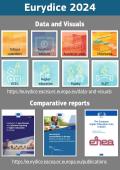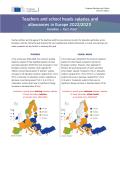Recommended Annual Instruction Time in Full-time Compulsory Education in Europe 2015/16
Full version EN
Comparative analysis: DE EL ES FR HR RO SK SLA SR
The Council of the European Union has set the goal of reducing low achievement in reading, mathematics and science among 15-year-olds' to less than 15 % by 2020. But how are European countries going to achieve this? Effective learning depends on many factors, but undoubtedly the instruction time available to students plays a role in their learning process. How can they best organise limited time between different subjects, ensuring that all students have the opportunity to develop their learning potential in a range of different areas?
This report analyses the recommended minimum instruction time by education level and across the four core curriculum subjects (i.e. reading, writing and literature; mathematics; natural sciences and foreign languages) in full-time general compulsory education in 37 European countries. The data refer to the minimum requirements set for the compulsory curriculum by the competent authorities of the 42 education systems covered in 2015/16.
The report provides a comparative overview on instruction time differences between primary and compulsory general secondary education. It identifies the main changes which occurred from 2010/11. It also includes national diagrams and maps illustrating the data on minimum instruction time by country and by subject.
The analysis shows that annual minimum instruction time tends to increase with the education level, and differences between countries become less significant. Reading, writing, and literature take up the largest share of the curriculum especially in primary education, while in secondary education the teaching of other languages becomes equally important.
The Eurydice network has been collecting data on instruction time for more than two decades and annually updated data on instruction time has been available on the Eurydice website since 2010.





